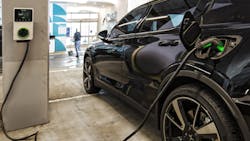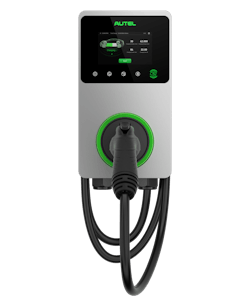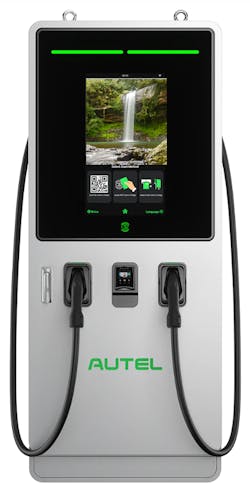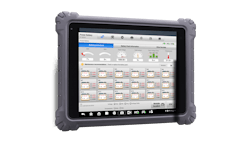Content brought to you by Motor Age. To subscribe, click here.
What you will learn:
• Levels 1, 2, and 3 make up the different classifications for EV charging
• The chargers and ECUs on the vehicle communicate during a charging event
• The battery state of charge and state of health is monitored while operating and while charging
The news is filled with stories about automakers going all-in on electric vehicles. Thirty-three electric models were released this year, and automakers like General Motors have plans for all-electric vehicle lines by the start of the next decade. The first step in servicing them is to get familiar with a few concepts.
Since the introduction of smart charging systems in the '90s, battery management systems (BMS) have existed in some form. Electric vehicles (EVs) have a more sophisticated BMS to help protect the high-voltage (HV) battery and extend its life.
Three main functions
Battery Protection: A BMS is designed to keep a battery safe (during its normal use) to operate the electric vehicle and while charging the HV battery. It does this by closely monitoring the pack's temperature at various locations, controlling the battery's voltage and amperage while driving and charging, and keeping the battery balanced amongst its cells. These are just a few of the BMS' primary functions in keeping the battery safe.
Battery monitoring: Throughout the operation and charging of the HV battery, the BMS monitors the state of charge (SoC) and its state of health (SoH).
Battery optimization: Its ability to monitor the above items accurately and closely will keep the battery properly balanced, which will help ensure the HV battery's long-term health. It will monitor the individual battery cell/block/module voltages by receiving specific voltage values (through the battery cell voltage PID monitoring physical connections).
The BMS can measure various strategically placed thermistors (temperature sensors) within an HV battery pack and can use this information to aid in thermal management of the pack and to help determine if there is a shorted cell within the battery pack. While the typical hybrid pack may only consist of 20-50 NiMH cells, it is not uncommon for a fully electric vehicle pack to consist of more than a thousand lithium-style cells.
The Vehicle Controls the Charge
Regarding charging an EV or plug-in hybrid vehicle (PHEV), we need to understand that the vehicle's onboard charging module (OBC) works in conjunction with the BMS to provide a safe charge of the vehicle's battery pack. A handshake occurs every time a charger is attached to the electric vehicle. Although DC Level 3 fast chargers can deliver 1,000 volts to the battery, most vehicles limit the voltage and amperage rate at which the battery can accept the charge (for safety reasons). During a typical charge, the BMS will also closely monitor the temperature of the HV battery pack to prevent the temperature from rising too high and potentially causing a fire.
As the number of electrified vehicles increases (and so does their need for servicing), it will become crucial for repair shops to purchase a Level 2 charger. These chargers output alternating current (AC), are very affordable, single-phase, and necessary to keep one's bays profitable. Unlike an internal combustion engine (ICE) that only burns fuel when running, EVs drain electrons most of the time while running them. For an electric vehicle, a charger is like a fuel can.
Level 1, level 2, and level 3 charging
Level 1: This usually involves using the emergency charger provided with the EV when purchased.
- Pros: a 110-volt cord able to be used on 15-amp circuits.
- Cons: Charging speed is slow; the battery will gain 3 to 5 miles of range for every hour of charging.
Level 2 charging: These are 220-volt style AC chargers that are single-phase. Pros: Can be hardwired or installed with standard NEMA 14-50 or 6-50 plugs into an existing outlet. Some Level 2 chargers, such as the Autel MaxiCharger Commercial chargers, are designed to enable shops to monetize charging, allowing drivers to pay to charge their vehicles. Via a cloud-based portal, shop owners can control and monitor the charging station/s. The Level 2 chargers offer dramatically faster charging; for every hour of charge, the battery gains 12 to 80 miles of range. Cons: They are still AC, meaning the vehicle's electronics found within the OBC and inverter will need to convert the electricity to DC before sending it to the battery. It may also be necessary to step up the voltage via the vehicle's DC-to-DC converter.
Level 3 DC fast charging: These units, sometimes referred to as SuperChargers, are three-phase 480V chargers. Pros: The voltage is already DC and, with the higher voltage, often doesn't require the usage of any of the vehicle's electronics to convert it. The Level 3 charging rate is typically 3 to 20 miles of range per charging minute. Cons: Higher initial infrastructure and out-of-pocket installation costs for charge point owners. Routinely using fast chargers may also affect the longevity of the HV battery.
There are two popular designs of charging connector types on EVs— the CCS and the J1772 plug standards. Note that the CCS has a J1772 atop the DC portion of the plug. The Tesla has its design; adapters enable the use of non-Tesla chargers.
It is safe to say that it is only a matter of time before EVs start appearing—if they haven't already— in your service bays for charging complaints or BMS-related DTCs. It is important that you have a thorough understanding of how these systems work and the proper tooling to diagnose these types of complaints.







